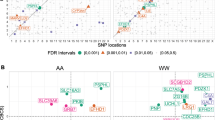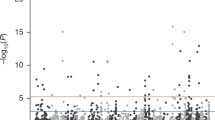Abstract
Germline mutations in BRCA1 or BRCA2 confer an increased lifetime risk of developing breast or ovarian cancer, but variable penetrance suggests that cancer susceptibility is influenced in part by modifier genes. Microarray expression profiling was conducted for 69 irradiated lymphoblastoid cell lines derived from healthy controls, or from cancer-affected women with a strong family history of breast and ovarian cancer carrying pathogenic mutations in BRCA1 or BRCA2, or with no BRCA1/2 mutations (BRCAX). Genes discriminating between BRCA1, BRCA2 or BRCAX and controls were stratified based on irradiation response and/or cell cycle involvement. Gene lists were aligned against genes tagged with single nucleotide polymorphisms (SNPs) determined by the Cancer Genetic Markers of Susceptibility (CGEMS) Breast Cancer Whole Genome Association Scan to be nominally associated with breast cancer risk. Irradiation responsive genes whose expression correlated with BRCA1 and/or BRCA2 mutation status were more likely to be tagged by risk-associated SNPs in the CGEMS dataset (BRCA1, P = 0.0005; BRCA2, P = 0.01). In contrast, irradiation responsive genes correlating with BRCAX status were not enriched in the CGEMS dataset. Classification of expression data by involvement in cell cycle processes did not enrich for genes tagged by risk-associated SNPs, for BRCA1, BRCA2 or BRCAX groups. Using a novel combinatorial approach, we have identified a subset of irradiation responsive genes as high priority candidate BRCA1/2 modifier genes. Similar approaches may be used to identify genes and underlying genetic risk factors that interact with exogenous stimulants to cause or modify any disease, without a priori knowledge of the pathways involved.
Similar content being viewed by others
References
Oldenburg RA, Meijers-Heijboer H, Cornelisse CJ et al (2007) Genetic susceptibility for breast cancer: how many more genes to be found? Crit Rev Oncol Hematol 63(2):125–149
Antoniou A, Pharoah PD, Narod S et al (2003) Average risks of breast and ovarian cancer associated with BRCA1 or BRCA2 mutations detected in case Series unselected for family history: a combined analysis of 22 studies. Am J Hum Genet 72(5):1117–1130
Simchoni S, Friedman E, Kaufman B et al (2006) Familial clustering of site-specific cancer risks associated with BRCA1 and BRCA2 mutations in the Ashkenazi Jewish population. Proc Natl Acad Sci USA 103(10):3770–3774
Smith A, Moran A, Boyd MC et al (2007) Phenocopies in BRCA1 and BRCA2 families: evidence for modifier genes and implications for screening. J Med Genet 44(1):10–15
Antoniou AC, Sinilnikova OM, Simard J et al (2007) RAD51 135G>C modifies breast cancer risk among BRCA2 mutation carriers: results from a combined analysis of 19 studies. Am J Hum Genet 81(6):1186–1200
Osorio A, Martinez-Delgado B, Pollan M et al (2006) A haplotype containing the p53 polymorphisms Ins16bp and Arg72Pro modifies cancer risk in BRCA2 mutation carriers. Hum Mutat 27(3):242–248
Rebbeck TR, Kantoff PW, Krithivas K et al (1999) Modification of BRCA1-associated breast cancer risk by the polymorphic androgen-receptor CAG repeat. Am J Hum Genet 64(5):1371–1377
Rebbeck TR, Wang Y, Kantoff PW et al (2001) Modification of BRCA1- and BRCA2-associated breast cancer risk by AIB1 genotype and reproductive history. Cancer Res 61(14):5420–5424
Spurdle AB, Antoniou AC, Duffy DL et al (2005) The androgen receptor CAG repeat polymorphism and modification of breast cancer risk in BRCA1 and BRCA2 mutation carriers. Breast Cancer Res 7(2):R176–R183
Spurdle AB, Antoniou AC, Kelemen L et al (2006) The AIB1 polyglutamine repeat does not modify breast cancer risk in BRCA1 and BRCA2 mutation carriers. Cancer Epidemiol Biomarkers Prev 15(1):76–79
Karran P (2000) DNA double strand break repair in mammalian cells. Curr Opin Genet Dev 10(2):144–150
Shivji MK, Davies OR, Savill JM et al (2006) A region of human BRCA2 containing multiple BRC repeats promotes RAD51-mediated strand exchange. Nucleic Acids Res 34(14):4000–4011
Broeks A, Braaf LM, Huseinovic A et al (2007) Identification of women with an increased risk of developing radiation-induced breast cancer: a case only study. Breast Cancer Res 9(2):R26
Mullan PB, Quinn JE, Harkin DP (2006) The role of BRCA1 in transcriptional regulation and cell cycle control. Oncogene 25(43):5854–5863
Marmorstein LY, Kinev AV, Chan GK et al (2001) A human BRCA2 complex containing a structural DNA binding component influences cell cycle progression. Cell 104(2):247–257
Mann GJ, Thorne H, Balleine RL et al (2006) Analysis of cancer risk and BRCA1 and BRCA2 mutation prevalence in the kConFab familial breast cancer resource. Breast Cancer Res 8(1):R12
Marsh A, Healey S, Lewis A et al (2007) Mutation analysis of five candidate genes in familial breast cancer. Breast Cancer Res Treat 105(3):377–389
Chenevix-Trench G, Healey S, Lakhani S et al (2006) Genetic and histopathologic evaluation of BRCA1 and BRCA2 DNA sequence variants of unknown clinical significance. Cancer Res 66(4):2019–2027
Jen KY, Cheung VG (2003) Transcriptional response of lymphoblastoid cells to ionizing radiation. Genome Res 13(9):2092–2100
Eberle MA, Ng PC, Kuhn K et al (2007) Power to detect risk alleles using genome-wide tag SNP panels. PLoS Genet 3(10):1827–1837
Easton DF, Pooley KA, Dunning AM et al (2007) Genome-wide association study identifies novel breast cancer susceptibility loci. Nature 447(7148):1087–1093
Bussey KJ, Kane D, Sunshine M et al (2003) MatchMiner: a tool for batch navigation among gene and gene product identifiers. Genome Biol 4(4):R27
Smith P, McGuffog L, Easton DF et al (2006) A genome wide linkage search for breast cancer susceptibility genes. Genes Chromosomes Cancer 45(7):646–655
Cox A, Dunning AM, Garcia-Closas M et al (2007) A common coding variant in CASP8 is associated with breast cancer risk. Nat Genet 39(3):352–358
Rahman N, Seal S, Thompson D et al (2007) PALB2, which encodes a BRCA2-interacting protein, is a breast cancer susceptibility gene. Nat Genet 39(2):165–167
Renwick A, Thompson D, Seal S et al (2006) ATM mutations that cause ataxia-telangiectasia are breast cancer susceptibility alleles. Nat Genet 38(8):873–875
Seal S, Thompson D, Renwick A et al (2006) Truncating mutations in the Fanconi anemia J gene BRIP1 are low-penetrance breast cancer susceptibility alleles. Nat Genet 38(11):1239–1241
Steffen J, Nowakowska D, Niwinska A et al (2006) Germline mutations 657del5 of the NBS1 gene contribute significantly to the incidence of breast cancer in Central Poland. Int J Cancer 119(2):472–475
Dubrovska A, Kanamoto T, Lomnytska M et al (2005) TGFbeta1/Smad3 counteracts BRCA1-dependent repair of DNA damage. Oncogene 24(14):2289–2297
Hu YF, Li R (2002) JunB potentiates function of BRCA1 activation domain 1 (AD1) through a coiled-coil-mediated interaction. Genes Dev 16(12):1509–1517
Preobrazhenska O, Yakymovych M, Kanamoto T et al (2002) BRCA2 and Smad3 synergize in regulation of gene transcription. Oncogene 21(36):5660–5664
Krendel M, Zenke FT, Bokoch GM (2002) Nucleotide exchange factor GEF-H1 mediates cross-talk between microtubules and the actin cytoskeleton. Nat Cell Biol 4(4):294–301
Wozniak MA, Desai R, Solski PA et al (2003) ROCK-generated contractility regulates breast epithelial cell differentiation in response to the physical properties of a three-dimensional collagen matrix. J Cell Biol 163(3):583–595
Gooch JL, Lee AV, Yee D (1998) Interleukin 4 inhibits growth and induces apoptosis in human breast cancer cells. Cancer Res 58(18):4199–4205
Balasubramanian SP, Azmy IA, Higham SE et al (2006) Interleukin gene polymorphisms and breast cancer: a case control study and systematic literature review. BMC Cancer 6:188
Consortium TIH (2003) The international HapMap project. Nature 426(6968):789–796
Papageorgio C, Brachmann R, Zeng J et al (2007) MAGED2: a novel p53-dissociator. Int J Oncol 31(5):1205–1211
Schuyer M, Berns EM (1999) Is TP53 dysfunction required for BRCA1-associated carcinogenesis? Mol Cell Endocrinol 155(1–2):143–152
Welch PJ, Wang JY (1993) A C-terminal protein-binding domain in the retinoblastoma protein regulates nuclear c-Abl tyrosine kinase in the cell cycle. Cell 75(4):779–790
Gery S, Komatsu N, Baldjyan L et al (2006) The circadian gene per1 plays an important role in cell growth and DNA damage control in human cancer cells. Mol Cell 22(3):375–382
Winter SL, Bosnoyan-Collins L, Pinnaduwage D et al (2007) Expression of the circadian clock genes Per1 and Per2 in sporadic and familial breast tumors. Neoplasia 9(10):797–800
Acknowledgements
We thank Sue Healey for providing assistance with BIC nomenclature and classifications, and David Hunter and Jonathan Beesley for helpful comments. We would like to thank all the Australian Red Cross Blood Services donors who participated as healthy controls in this study, Rachelle Morris and the staff at the Australian Red Cross Blood Services for their assistance with the collection of risk factor information and blood samples, and Helene Holland for data management, Mary-Anne Kedda, Joanne Young, Melanie Higgins, Kimberly Hinze, Robert Smith, Judith Clements, Melissa Barker, Rebecca Magson, Genevieve Birney and other members of the Molecular Cancer Epidemiology Laboratory, for their assistance with collection and processing of Australian Red Cross Blood Services blood samples. We thank Denis Moss for access to LCLs from controls recruited through the QIMR. We also wish to thank Heather Thorne, Eveline Niedermayr, Jan Groves, Amber Williams, the kConFab mutation review committee, kConFab research nurses and staff, the heads and staff of the Family Cancer Clinics, and the Clinical Follow Up Study (funded by NHMRC grants 145684 and 288704) for their contributions to this resource, and the many families who contribute to kConFab. kConFab is supported by grants from the National Breast Cancer Foundation, the National Health and Medical Research Council (NHMRC) and by the Queensland Cancer Fund, the Cancer Councils of New South Wales, Victoria, Tasmania and South Australia, and the Cancer Foundation of Western Australia. This research was supported by a grant from the Susan G. Komen Breast Cancer Foundation, and the NHMRC. LCW was supported by funding from NHMRC, NW was supported by funding from the National Breast Cancer Foundation, SMG is an NMHRC Senior Research Fellow, and ABS is a recipient of an NHMRC Career Development Award.
Author information
Authors and Affiliations
Consortia
Corresponding author
Electronic supplementary material
Rights and permissions
About this article
Cite this article
Walker, L.C., Waddell, N., Ten Haaf, A. et al. Use of expression data and the CGEMS genome-wide breast cancer association study to identify genes that may modify risk in BRCA1/2 mutation carriers. Breast Cancer Res Treat 112, 229–236 (2008). https://doi.org/10.1007/s10549-007-9848-5
Received:
Accepted:
Published:
Issue Date:
DOI: https://doi.org/10.1007/s10549-007-9848-5




